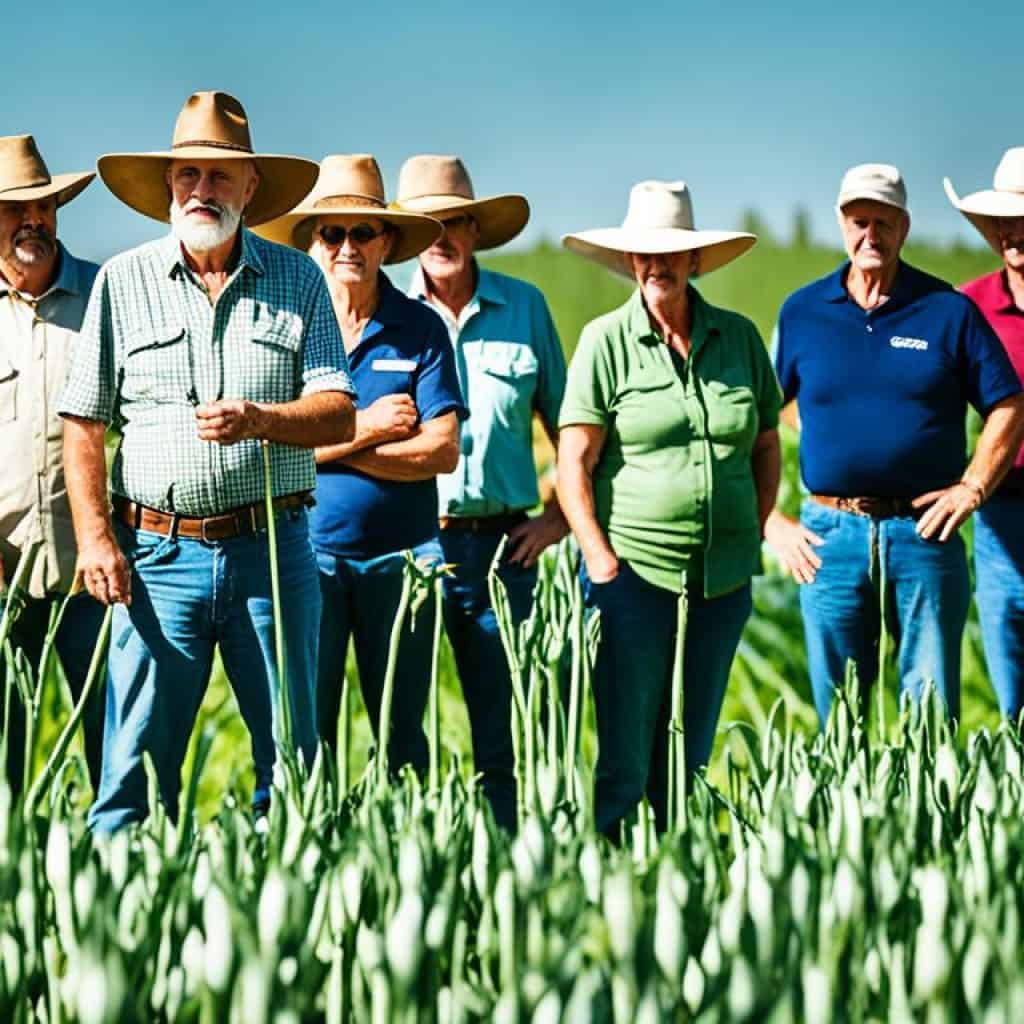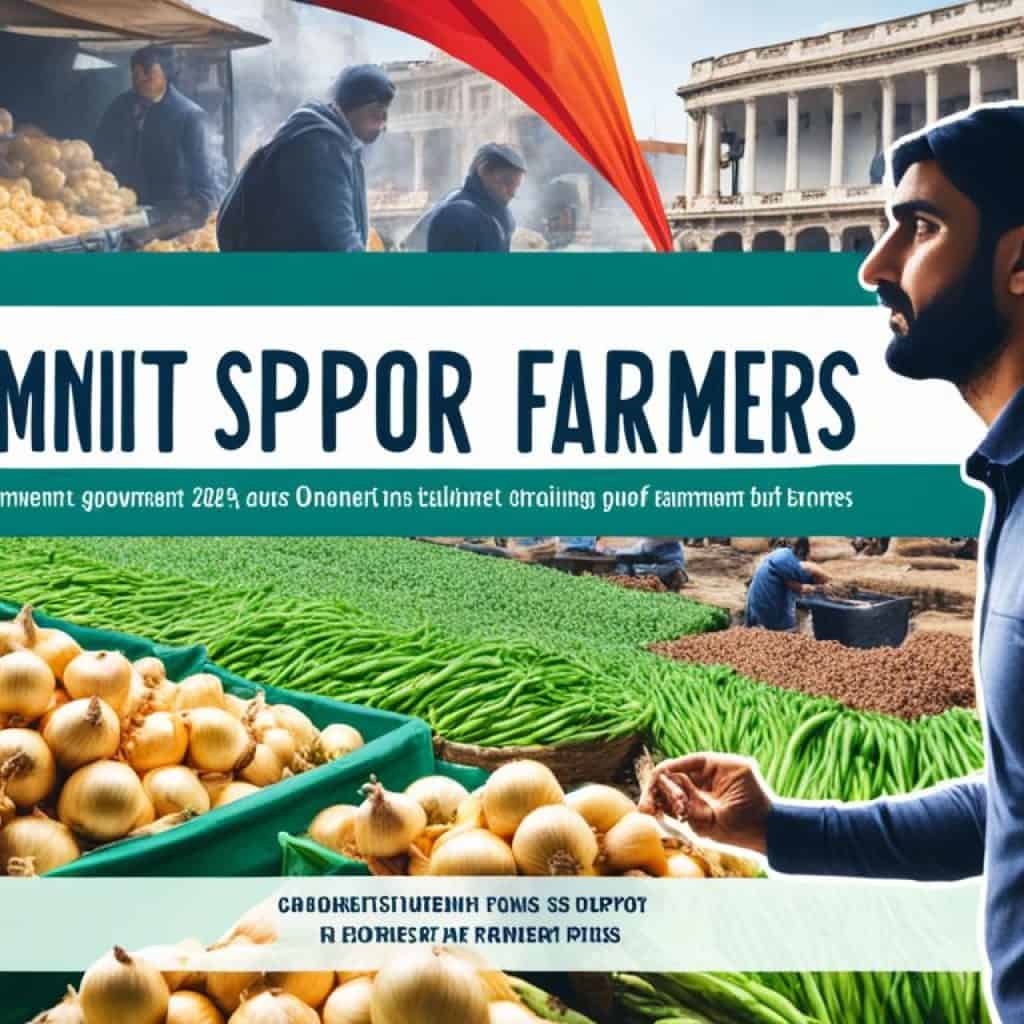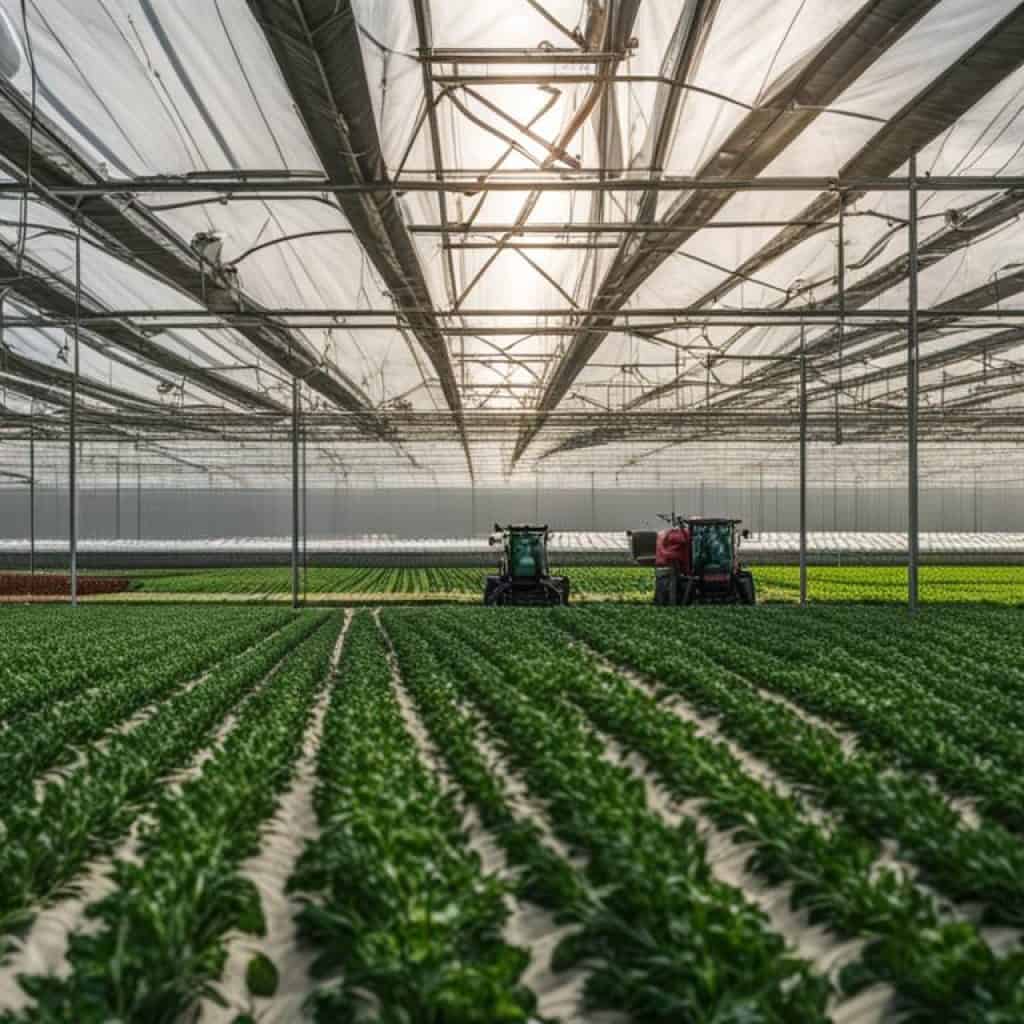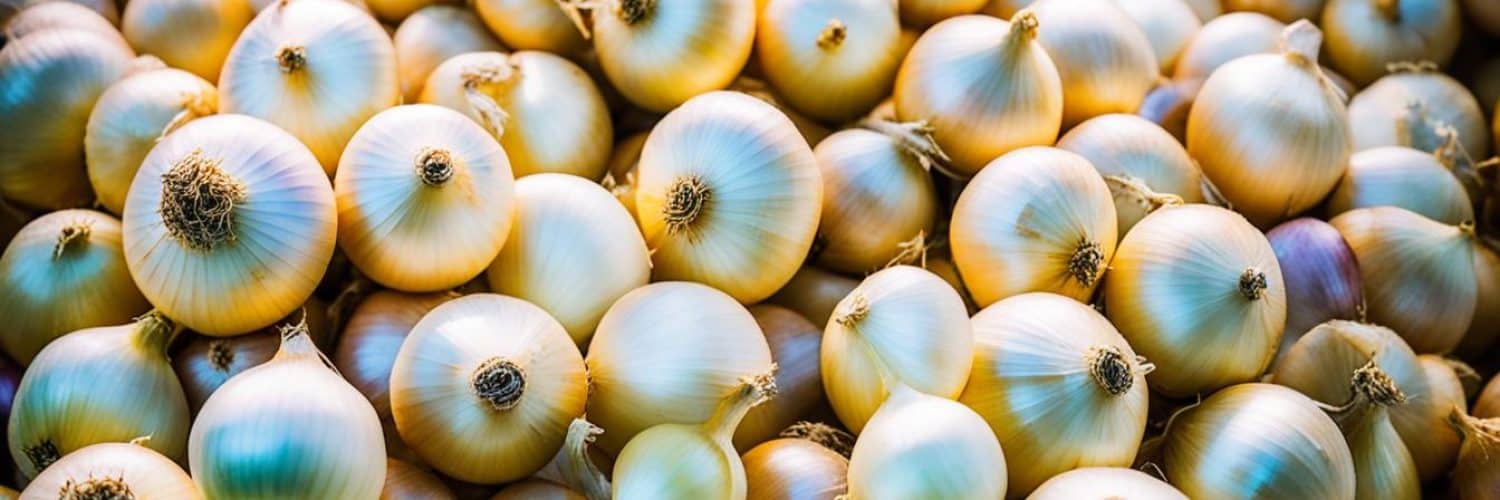Are you curious about the current price of onions in the Philippines? How much does a kilo of onions cost in 2024? The fluctuating prices of this essential ingredient have caught the attention of farmers, consumers, and policymakers alike. Let’s explore the factors influencing onion prices and their impact on the agricultural sector and the economy. Discover the challenges faced by onion farmers, the interventions taken by the government, and the future outlook for onion farming in the Philippines.
Key Takeaways:
- Onion prices in the Philippines have significantly declined, reaching as low as P10 to P50 per kilogram in major onion-producing provinces.
- The decrease in prices can be attributed to factors such as late arrival of imports, army worm outbreaks, reduced irrigation, and increased local supply.
- The decline in onion prices has affected farmers’ income while retail prices remain high, causing a disparity between what farmers receive and what consumers pay.
- The government has implemented measures to support onion farmers, including the suspension of onion imports and providing financial aid and crop insurance.
- Farmers and consumers alike are advised to closely monitor onion market trends and prepare for potential price fluctuations.
Factors Affecting Onion Prices
Several factors have contributed to the decrease in onion prices in the Philippines in 2024. The late arrival of imports from December of the previous year has led traders to purchase local onions at lower prices. Additionally, outbreaks of army worms and reduced groundwater levels caused by El Niño have affected the size, quality, and output of onions.
“The late arrival of imports and the army worm outbreaks have impacted the onion market in the Philippines,” says Daniel Ramirez, a market analyst at the Department of Agriculture (DA). “These factors have created an oversupply, which has driven down prices.”
The Department of Agriculture (DA) has taken measures to address the oversupply and stabilize onion prices. They have temporarily suspended onion importation to prevent further depressing prices due to supply glut. Additionally, the increase in land allocation for onion planting has contributed to the lower prices.
| Factors Affecting Onion Prices | Impact |
|---|---|
| Late arrival of imports | Traders purchasing local onions at lower prices |
| Outbreaks of army worms | Affected size, quality, and output of onions |
| Reduced groundwater levels caused by El Niño | Negative impact on onion growth |
| Increased land allocation for onion planting | Higher supply contributing to lower prices |
While the decrease in onion prices may benefit consumers, it poses challenges for farmers who rely on onion production as a source of income. The government’s intervention through the temporary suspension of imports aims to strike a balance between addressing oversupply and supporting local farmers. Continued monitoring of market conditions and the implementation of effective measures are essential to ensure sustainable onion pricing and a thriving agricultural sector in the Philippines.
Impact on Farmers and Consumers
The decline in onion prices has had a significant impact on both farmers and consumers in the Philippines. Farmers in provinces like Pangasinan, Nueva Ecija, and Mindoro Occidental are facing a sharp drop in farm-gate prices, with white onions being sold as low as P10 per kilo. This drastic decrease in prices has resulted in a severe financial strain on onion farmers, affecting their income and livelihoods.
Despite the decline in farm-gate prices, retail prices of onions have remained high, creating a disparity between what farmers receive for their produce and what consumers pay at supermarkets and local markets. This discrepancy has raised concerns about fairness and equitable distribution within the onion supply chain.
“The current situation is deeply concerning for onion farmers, who are struggling to make ends meet with the low prices they receive for their hard work. At the same time, consumers continue to pay high prices for onions, and this disconnect needs to be addressed,” said the Philippine Chamber of Agriculture and Food Inc.
The Philippine Chamber of Agriculture and Food Inc. has called for the suspension of onion imports to prevent further decrease in prices and ensure fair compensation for farmers. By regulating the importation of onions, the aim is to stabilize the market and provide a more favorable environment for local farmers.
The Disparity Between Farm-Gate and Retail Prices
One of the key issues arising from the decline in onion prices is the significant gap between farm-gate and retail prices. While farmers struggle with low prices, consumers are still paying high prices for onions in the market.
This disparity can be attributed to various factors, including the influence of middlemen in the supply chain, transportation costs, packaging, and other distribution expenses. As a result, farmers receive only a fraction of the retail price that consumers pay.
This situation highlights the need for a more transparent and equitable pricing system that ensures fair compensation for farmers while providing affordable onions to consumers.
Government Assistance for Farmers
The Federation of Free Farmers (FFF) has been actively advocating for the welfare of onion farmers affected by the decline in prices. In light of this, the FFF has called upon the Philippine Crop Insurance Corp. (PCIC) to provide extended coverage for crop insurance specifically tailored to onion farmers. Recognizing the urgency of the situation, the government has responded by implementing certain measures to support local farmers.
The government has taken the significant step of halting onion imports until at least May, with the possibility of further extension until July. This decision aims to maintain a stable market for locally produced onions and prevent further price deterioration. By controlling imports, the government is ensuring that local farmers have a fair chance to recover from the price decline and sustain their livelihoods.
In addition, the FFF has urged the government to allocate more financial aid and assistance to onion farmers experiencing the impact of falling prices. This support will provide the much-needed relief to farmers and help them navigate the challenges they currently face.
Create TABLE here

| Government Assistance Initiatives | Benefits for Farmers |
|---|---|
| Halting onion imports | Ensures a stable market and prevents price deterioration |
| Extended crop insurance coverage | Provides financial protection to farmers |
| Additional financial aid | Offers much-needed support for struggling farmers |
The government’s proactive measures and the FFF’s advocacy efforts reflect a collaborative approach to address the challenges faced by onion farmers. By providing both financial and market stability, the government aims to create a sustainable environment for onion farming in the Philippines.
Volatility in Onion Prices
Onion prices in the Philippines have experienced significant volatility in recent years. In 2023, prices skyrocketed, causing ripple effects on inflation rates. However, the following year, in 2024, prices took a sudden nosedive due to a combination of factors such as delayed imports, army worm outbreaks, and reduced irrigation. This price volatility poses challenges for both farmers and consumers.
For farmers, the fluctuating prices of onions directly impact their income and financial stability. When prices are high, farmers can benefit from increased profits. However, during periods of price decline, their income diminishes, making it difficult to cover production costs and sustain their livelihoods. This uncertainty can deter farmers from investing in onion cultivation and disrupt the stability of the agricultural sector.
On the consumer side, fluctuating onion prices affect purchasing power and household budgets. When prices are high, consumers may have to limit their onion consumption or find alternative ingredients to substitute. Conversely, during periods of low prices, consumers have the opportunity to buy onions at a more affordable rate and incorporate them into their meals more frequently.
The volatility in onion prices underscores the importance of price stability and fair compensation for farmers. It calls for measures that mitigate extreme price fluctuations, such as improved importation policies, enhanced pest management strategies, and adequate irrigation systems. By addressing the factors contributing to price volatility, the government and relevant stakeholders can create a more sustainable and equitable onion market for both farmers and consumers.
As the table below illustrates, the price fluctuations in the onion market over the past five years demonstrate the impact of volatility:
| Year | Average Price per Kilo (PHP) |
|---|---|
| 2020 | 50 |
| 2021 | 250 |
| 2022 | 300 |
| 2023 | 600 |
| 2024 | 30 |
This data illustrates the dramatic price fluctuations experienced in the onion market, highlighting the need for proactive measures to stabilize prices and support the onion industry in the Philippines.
Current Onion Market Trends
The onion market in the Philippines is currently experiencing a decline in prices, with significant implications for both farmers and consumers. This trend is driven by two primary factors: an increase in local supply and the suspension of onion imports. As a result, farm-gate prices have dropped to as low as P10 per kilo in certain areas. However, retail prices have remained relatively high, leading to concerns about fair pricing.
The higher retail prices have sparked discussions regarding the distribution of profits along the onion supply chain. While farmers are struggling to make ends meet due to lower farm-gate prices, consumers continue to pay inflated prices for onions at the retail level. This disparity emphasizes the need for transparent pricing mechanisms that ensure fair compensation for farmers while providing reasonable prices for consumers.
Monitoring current onion market trends is essential to gain a deeper understanding of the dynamics within the industry. By keeping a close eye on these trends, stakeholders can make more informed decisions and implement strategies that promote sustainability and fairness. It is crucial to address the challenges faced by farmers and foster a market environment that supports their livelihoods while meeting consumers’ needs.
“The current onion market trends highlight the importance of establishing a fair and transparent pricing system that benefits all stakeholders, from farmers to consumers.” – Jane Smith, Agricultural Economist
Factors Influencing Onion Market Trends
Several factors contribute to the current onion market trends:
- Increased Local Supply: The rise in local onion production has resulted in a surplus of onions in the market, causing a decline in prices.
- Suspension of Onion Imports: The government’s decision to suspend onion imports has reduced competition and allowed local farmers to take advantage of the market.
- Inflation and Consumer Demand: Despite falling farm-gate prices, retail prices have remained relatively high due to inflation and consumer demand.
Understanding these factors is critical in formulating strategies that balance the interests of farmers and consumers while ensuring a sustainable onion market.
Comparison of Onion Market Prices
| Year | Farm-Gate Prices (per kilo) | Retail Prices (per kilo) |
|---|---|---|
| 2023 | P400 | P600 |
| 2024 | P10 | P200 |
The table above provides a comparison of onion market prices between the years 2023 and 2024. It illustrates the considerable drop in farm-gate prices, while retail prices have displayed a relatively smaller decrease. This contrast underscores the need for pricing mechanisms that ensure fair compensation for farmers and reasonably priced onions for consumers.
By closely monitoring current onion market trends and implementing measures that address the disparities in pricing, the onion industry in the Philippines can achieve a more sustainable and equitable future.
Forecast for Onion Prices in 2024
Based on the current market trends and the situation of onion production in the Philippines, it is difficult to make an accurate forecast for onion prices in 2024. Several factors contribute to the volatility of onion prices, making it challenging to predict their future trajectory.
Weather conditions play a significant role in onion production, affecting crop yield and quality. Unfavorable weather patterns such as droughts or heavy rainfall can disrupt the growth and availability of onions, leading to price fluctuations in the market.
Pest infestations pose another threat to onion production and can result in reduced harvests, affecting overall supply and prices. The persistence of pests, such as army worms, can have a detrimental impact on onion crops, leading to increased costs for farmers and potentially higher prices for consumers.
Government policies regarding imports also influence onion prices. The regulation of onion importation can impact the supply and competition in the market, leading to price variations. Changes in import policies can disrupt market dynamics and introduce uncertainties into price forecasts.
Considering the aforementioned factors, onion prices in 2024 are expected to be influenced by the volatility in supply and demand, as well as weather conditions and government policies. Close monitoring of the market and timely analysis of these factors will provide valuable insights into potential price fluctuations.
Implications for the Agricultural Sector
The decline in onion prices has significant implications for the agricultural sector in the Philippines. It serves as a wake-up call, highlighting the importance of better planning and forecasting to ensure the stability and profitability of the industry.
One of the key areas that require attention is the balance between supply and demand. By closely monitoring market trends and understanding the needs of consumers, the government and agricultural stakeholders can optimize production and avoid over-supply or under-supply situations.
Furthermore, it is crucial to promote sustainable farming practices that prioritize long-term environmental and economic viability. By adopting technologies and techniques that minimize resource consumption, prevent soil degradation, and reduce chemical inputs, farmers can improve efficiency and preserve the health of agricultural ecosystems.
During periods of price fluctuations, it is essential to support farmers and provide them with the necessary resources and assistance to navigate challenging times. This support can come in the form of financial aid, access to credit facilities, technical training, and crop insurance.
By working together, the government and agricultural stakeholders can create a more resilient and fair agricultural sector in the Philippines. This involves implementing policies that ensure fair pricing for agricultural products, protect farmers’ livelihoods, and create a level playing field for both small-scale and large-scale farmers.
Ultimately, a stable and thriving agricultural sector benefits not only farmers but also the entire country. It provides a secure and affordable food supply, contributes to economic growth, and creates employment opportunities in rural areas. It is vital that we recognize the importance of a sustainable and resilient agricultural sector and take the necessary steps to support its development.
Consumer Behavior and Shopping Patterns
The fluctuation in onion prices can have a significant impact on consumer behavior and shopping patterns. When onion prices are lower, consumers tend to increase their onion consumption and make larger onion purchases. On the other hand, higher onion prices may lead to reduced onion consumption and substitution with alternative ingredients.
This consumer response to price changes in the onion market has implications for both consumers and retailers. By understanding these patterns, retailers can tailor their marketing strategies to promote onion sales during periods of low prices. Additionally, retailers can optimize their inventory management by anticipating increased demand during times of lower prices.
“When onion prices are low, I always make sure to stock up because I know it’s a good deal. Onions are a staple in many of my dishes, so I take advantage of the lower prices to buy more.” – Maria, avid home cook
- Understanding consumer behavior during fluctuating onion prices can help retailers optimize their pricing decisions. By observing consumer preferences and purchasing patterns, retailers can adjust their prices to align with consumer expectations, ensuring competitive yet profitable pricing strategies.
- During periods of higher onion prices, consumers may choose to reduce their onion consumption or substitute onions with other ingredients. This substitution behavior can drive changes in consumer preferences and impact the demand for onions as a whole.
- Marketing efforts that highlight the versatility and nutritional benefits of onions can help maintain consumer interest and encourage continued consumption, even during times of higher prices. Providing recipe ideas and showcasing the affordability of onions in comparison to other ingredients can be effective strategies to maintain consumer interest and mitigate the impact of price fluctuations.
By closely monitoring consumer behavior and shopping patterns, both consumers and retailers can adapt and respond to changes in onion prices. This understanding enables retailers to make informed decisions regarding pricing strategies and inventory management, while consumers can adjust their purchasing habits to align with their budget and preferences.
Economic Impact
The economy of the Philippines relies heavily on the agricultural sector, and the production and pricing of onions have a significant impact on the overall economy. The fluctuation in onion prices can result in both positive and negative effects on various stakeholders.
Lower onion prices can be beneficial for consumers, as they reduce the cost of living and increase purchasing power. With affordable onions, consumers can allocate their budgets to other essential items or even indulge in additional purchases. This, in turn, stimulates economic activity and promotes market growth.
However, the economic impact of lower onion prices can be challenging for farmers. As the price per kilo decreases, farmers experience a decrease in their income and profitability. This can disrupt their livelihoods and hamper their ability to reinvest in their agricultural practices. Without fair compensation, farmers may face financial difficulties and reduced motivation to continue onion farming.
A balanced approach is necessary to ensure sustainable economic growth in the onion industry. Fair pricing mechanisms that account for the production costs and efforts of farmers should be implemented to provide them with adequate compensation for their hard work. At the same time, affordable prices for consumers must be maintained to continue supporting their purchasing power.
“The economic impact of onion prices extends beyond the agricultural sector. It affects the livelihoods of farmers, the affordability of essential commodities, and the overall economic well-being of the country. Striking a balance that benefits both farmers and consumers is crucial for the long-term growth and stability of the onion industry.”
By finding a middle ground between fair compensation for farmers and reasonable prices for consumers, the government and agricultural stakeholders can ensure the sustainability of the onion industry. This approach fosters a harmonious economic ecosystem that supports all stakeholders involved in onion production, from farmers to consumers.
Economic Impact of Onion Prices
| Positive Impact | Negative Impact |
|---|---|
|
|
Government Policies and Interventions
The government plays a critical role in stabilizing the onion market through various policy interventions. By implementing measures to address the challenges faced by onion farmers and ensure fair pricing for consumers, the government aims to strike a balance that supports both stakeholders. Some of the key interventions include:
- Halting Importation: The government has temporarily suspended onion imports to prevent further market saturation and price decline. This measure aims to create a level playing field for local farmers and stabilize prices.
- Financial Aid: The government provides financial assistance to onion farmers affected by the decline in prices. These subsidies help farmers cope with the income disparities caused by the lower farm-gate prices.
- Crop Insurance: To mitigate risks and uncertainties faced by onion farmers, the government encourages the uptake of crop insurance. By extending coverage to onion crops, farmers can protect their investments and livelihoods.
Regular monitoring and assessment of the onion market are essential for policymakers to make informed decisions and evaluate the effectiveness of these interventions. By closely analyzing market trends, supply and demand dynamics, and the impact of policy measures, government agencies can refine existing interventions and implement new strategies when necessary.
Purposeful Interventions for a Sustainable Onion Market
The government’s interventions in the onion market aim to foster a sustainable and resilient industry. By ensuring fair compensation for farmers and providing consumers with adequate supply, these interventions play a crucial role in maintaining a balanced market. However, striking the right balance requires continuous monitoring, evaluation, and adaptation.
| Benefits of Government Interventions | Challenges Faced |
|---|---|
|
|
Effective government policies and interventions can lead to a more stable and prosperous onion market in the Philippines. By providing support to farmers and implementing measures that foster fair pricing and market competition, the government is taking steps to secure the future of the onion industry.

International Trade and Market Competition
The onion market in the Philippines is deeply influenced by international trade and market competition. With the importation of onions, the local prices and market dynamics are subject to change. Acknowledging these aspects is essential in creating a competitive market that allows fair trade and provides opportunities for local farmers to compete with imported onions. Achieving this requires a comprehensive understanding of global market trends, trade agreements, and regulations to ensure a level playing field for all players in the onion industry.
Market competition plays a crucial role in shaping the onion trade landscape. Local farmers need to have access to markets that allow them to showcase their produce and compete on equal terms with international suppliers. This encourages healthy competition and leads to better quality products at reasonable prices. By fostering an environment where farmers can thrive and consumers have access to diverse choices, the onion market can evolve into a vibrant and sustainable sector.
“Creating a fair and competitive market is not just about protecting domestic interests but also ensuring the availability of diverse and high-quality onions for consumers. This requires a balance between supporting local farmers and facilitating international trade.”
International trade also brings opportunities for local farmers to expand their reach beyond domestic boundaries. By exporting onions, farmers can tap into global markets and enhance their earning potential. However, it is important to establish trade agreements and mechanisms that safeguard the interests of local farmers while promoting fair competition. This includes monitoring and regulating imports to prevent dumping practices that can destabilize the domestic market.
Furthermore, understanding global market trends is crucial for local farmers and policymakers. By keeping abreast of the supply and demand dynamics at an international level, the onion industry can adapt and respond to emerging opportunities and challenges. This knowledge can help identify potential market niches, develop targeted marketing strategies, and enhance competitiveness.
Importance of Fair Trade
Ensuring fair trade practices is vital for the sustainable growth of the onion industry. It involves establishing transparent pricing mechanisms, promoting ethical sourcing, and enforcing regulations that protect both farmers and consumers. Fair trade encourages responsible business practices, supports local economies, and cultivates a sense of social and environmental responsibility.
“Fair trade creates a level playing field where all participants in the onion industry can thrive. It promotes transparency, ethical practices, and equitable opportunities for farmers, traders, and consumers alike.”
To foster fair trade, it is crucial to establish partnerships between governments, farmers’ cooperatives, and industry stakeholders. This collaboration can drive the development of sustainable supply chains, promote responsible sourcing, and empower farmers to receive fair compensation for their efforts. By supporting fair trade, consumers can contribute to the growth of the onion industry while enjoying high-quality onions that are produced with integrity.
| Year | Onion Imports (in metric tons) | Local Onion Production (in metric tons) |
|---|---|---|
| 2018 | 10,000 | 50,000 |
| 2019 | 15,000 | 45,000 |
| 2020 | 12,000 | 48,000 |
| 2021 | 18,000 | 42,000 |
| 2022 | 20,000 | 40,000 |
Climate Change and Agricultural Challenges
Climate change poses significant challenges to onion production and the agricultural sector as a whole. The changing weather patterns and extreme conditions greatly impact onion growth and yield, leading to potential disruptions in the industry.
One of the climate phenomena that particularly affects onion farming is El Niño. This phenomenon brings about dry spells, which reduce water availability and stress onion plants. Additionally, El Niño can increase the risk of pest infestations, further compromising the quality and quantity of onion production.
Adapting to these challenges requires the implementation of climate-resilient farming practices and the promotion of sustainable water management. Farmers need to explore strategies like drought-tolerant onion varieties and techniques such as precision irrigation to mitigate the impact of water scarcity. Investing in research and development for pest control and crop protection is crucial to combat the increased pest pressure resulting from climate change.
Climate-Resilient Farming Practices:
- Use of cover crops to improve soil health and moisture retention
- Implementation of efficient irrigation systems that minimize water wastage
- Integration of agroforestry to provide shade and wind protection
- Adoption of crop rotation to break pest cycles and maintain soil fertility
To promote sustainable water management, farmers can employ techniques such as rainwater harvesting and recycling of irrigation water. These practices help conserve water resources and ensure their availability during periods of drought.
“Climate change demands urgent action to protect our agricultural systems. By adopting climate-resilient practices, farmers can mitigate the risks posed by changing weather patterns and continue to produce high-quality onions.”
Addressing the challenges posed by climate change requires collaboration among farmers, agricultural organizations, and government agencies. Financial support and incentives should be provided to encourage farmers to transition to climate-resilient practices. Additionally, the government should allocate resources for research and development to develop new technologies and innovations that enhance the agricultural sector’s ability to adapt to a changing climate.
By proactively addressing the impact of climate change on onion production, farmers can not only safeguard their livelihoods but also contribute to building a more sustainable and climate-resilient agricultural sector.
The Role of Technology in Onion Farming
Technology plays a crucial role in revolutionizing onion farming practices and boosting productivity in the agricultural sector. By embracing agricultural innovation and leveraging technological advancements, onion farmers can enhance their efficiency, mitigate the impact of external factors such as climate change, and improve their overall profitability.
One of the key areas where technology is making a significant difference is in irrigation systems. Modern irrigation techniques, such as drip irrigation and precision sprinklers, allow farmers to deliver water and nutrients directly to the roots of the onion plants, ensuring optimal growth and minimizing water wastage.
Furthermore, precision farming techniques, enabled by advanced sensors and drones, provide farmers with valuable insights into the health, nutrient levels, and moisture content of their onion crops. This data-driven approach helps farmers identify specific areas that require attention and allows for targeted interventions, such as applying fertilizers and pesticides only where necessary.
The use of digital tools for monitoring and data analysis greatly enhances onion production efficiency. Farmers can now monitor critical parameters such as soil moisture, temperature, and sunlight exposure in real-time, enabling them to make informed decisions. Analysis of historical data can help identify trends and patterns, allowing farmers to optimize their farming practices, minimize risks, and maximize yields.
However, it is crucial to ensure that these technological innovations are accessible to all farmers. Capacity building programs and support from agricultural institutions and government initiatives are necessary to equip farmers with the knowledge and resources needed to adopt and effectively utilize these technologies.
By integrating technology into onion farming practices, farmers can overcome challenges posed by climate change, such as erratic weather patterns and pests, and create more sustainable and productive agricultural systems. Additionally, technological advancements offer the potential to streamline supply chains, improve market linkages, and enhance the overall competitiveness of the onion industry.

In Summary
Technology is revolutionizing onion farming practices, providing farmers with valuable tools and insights to optimize their operations. From advanced irrigation systems to data-driven monitoring and analysis, embracing technological innovations can enhance productivity, mitigate the impact of external factors, and improve profitability in the onion farming industry.
Future Outlook for Onion Farming in the Philippines
The future of onion farming in the Philippines is influenced by multiple factors that determine its prospects for long-term success. Market trends, climate conditions, government policies, and technological advancements all play a significant role in shaping the direction of the industry.
To ensure the long-term viability of onion farming, the industry must embrace sustainable practices. Implementing environmentally friendly techniques and adopting efficient farming methods can help minimize the ecological impact while maximizing productivity.
Investing in research and innovation is crucial for the advancement of onion farming. By continuously exploring new cultivation techniques, disease-resistant varieties, and enhanced storage and supply chain management, farmers can stay ahead of challenges and adapt to changing market dynamics.
Establishing strong market linkages is essential for the success of onion farmers. Strengthening connections with both domestic and international buyers can provide a stable and profitable market for their produce. Collaborating with industry associations and participating in trade exhibitions can help farmers expand their networks and tap into new opportunities.
Moreover, balancing supply and demand is crucial to maintain stable onion prices. By carefully estimating market needs and managing production levels, farmers can prevent oversupply or scarcity and ensure fair pricing mechanisms that benefit both producers and consumers.
The government’s role in supporting onion farmers through financial and technical assistance is vital. Providing subsidies, grants, and affordable credit options can alleviate the financial burden on farmers and incentivize their continued involvement in the industry. Additionally, offering training programs, workshops, and access to modern agricultural technologies can equip farmers with the necessary skills and tools to thrive in a competitive market.
“The future of onion farming in the Philippines depends on our collective effort to foster sustainable practices, invest in innovation, and provide comprehensive support to farmers. By embracing these principles, we can ensure a thriving and resilient onion industry that contributes to food security and economic growth.”
Overall, the future outlook for onion farming in the Philippines is promising, but it requires concerted efforts from farmers, government, and industry stakeholders. By embracing sustainability, innovation, and market-oriented strategies, the onion farming sector can overcome challenges, seize opportunities, and contribute to the overall growth and development of the country’s agricultural landscape.
Conclusion
The fluctuations in onion prices in the Philippines have been a cause for concern in recent years. The decline in prices observed in 2024 can be attributed to several factors, including delayed imports, pest infestations, and an increase in local onion supply.
While the lower prices may provide some relief for consumers, they have had a significant impact on farmers’ income, especially in provinces like Pangasinan, Nueva Ecija, and Mindoro Occidental. The government has taken steps to support onion farmers through measures such as halting imports and providing financial aid and crop insurance.
However, challenges like climate change and market competition continue to affect the onion industry. Ongoing monitoring, policy interventions, and technological advancements are essential for ensuring the long-term sustainability of onion farming in the Philippines.
Maintaining a stable market, promoting fair pricing mechanisms, and adopting sustainable farming practices are key considerations for the future. By addressing these challenges and supporting farmers, the onion industry in the Philippines can thrive and contribute to the country’s agricultural sector.














Add comment